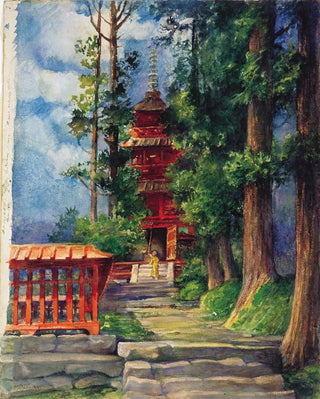Art print | Red Pagoda of Nikkō - John La Farge


View from behind

Frame (optional)
Nikkō Red Pagoda Art print by John La Farge – Captivating Introduction
The Nikkō Red Pagoda, an iconic work by John La Farge, transports us to a universe where natural beauty and artistic expression intertwine with striking harmony. This painting, which evokes the serenity of Japanese landscapes, is much more than a simple representation. It embodies a quest for peace and contemplation, inviting the viewer to immerse themselves in a world imbued with mystery and spirituality. The delicacy of the details and the subtle use of colors make this piece a true window into another time and place, where nature and architecture meet in a delicate dance.
Style and uniqueness of the work
La Farge's style is characterized by a unique approach that blends Impressionism with Japanese influences. In the Nikkō Red Pagoda, the artist manages to capture light in an exceptional way, creating vibrant reflections that seem to dance on the water's surface and the surrounding foliage. The shades of red, green, and gold combine to bring this scene to life, while the carefully orchestrated composition guides the viewer's eye across the painting. The pagoda, with its refined architecture, rises majestically amidst a lush landscape, evoking a sense of peace and serenity. The way La Farge plays with perspective and depth gives the work an almost three-dimensional quality, immersing the viewer in an engaging experience.
The artist and his influence
John La Farge, an American painter and decorator, made his mark with his innovative approach to oil painting and stained glass. His fascination with the Orient, particularly Japan, is reflected in several of his works, including the Nikkō Red Pagoda. La Farge is recognized for his ability to incorporate elements from different cultures into his art, creating a distinctive style that transcends borders. His influence is felt not only in the art world but also in architecture and design, where he helped popularize motifs and techniques inspired by Asia. His artistic vision, blending tradition and modernity,

Matte finish

View from behind

Frame (optional)
Nikkō Red Pagoda Art print by John La Farge – Captivating Introduction
The Nikkō Red Pagoda, an iconic work by John La Farge, transports us to a universe where natural beauty and artistic expression intertwine with striking harmony. This painting, which evokes the serenity of Japanese landscapes, is much more than a simple representation. It embodies a quest for peace and contemplation, inviting the viewer to immerse themselves in a world imbued with mystery and spirituality. The delicacy of the details and the subtle use of colors make this piece a true window into another time and place, where nature and architecture meet in a delicate dance.
Style and uniqueness of the work
La Farge's style is characterized by a unique approach that blends Impressionism with Japanese influences. In the Nikkō Red Pagoda, the artist manages to capture light in an exceptional way, creating vibrant reflections that seem to dance on the water's surface and the surrounding foliage. The shades of red, green, and gold combine to bring this scene to life, while the carefully orchestrated composition guides the viewer's eye across the painting. The pagoda, with its refined architecture, rises majestically amidst a lush landscape, evoking a sense of peace and serenity. The way La Farge plays with perspective and depth gives the work an almost three-dimensional quality, immersing the viewer in an engaging experience.
The artist and his influence
John La Farge, an American painter and decorator, made his mark with his innovative approach to oil painting and stained glass. His fascination with the Orient, particularly Japan, is reflected in several of his works, including the Nikkō Red Pagoda. La Farge is recognized for his ability to incorporate elements from different cultures into his art, creating a distinctive style that transcends borders. His influence is felt not only in the art world but also in architecture and design, where he helped popularize motifs and techniques inspired by Asia. His artistic vision, blending tradition and modernity,






